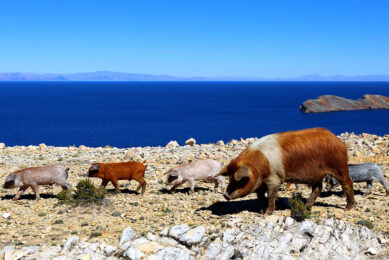Campylobacter food poisoning – good news for pigs!
Campylobacter species are the commonest cause of food poisoning in man, affecting over 50,000 people in the UK and 69/100,000 population in Denmark each year, but Danish researchers have shown that potentially, only a small fraction of pig isolates are associated with man and these strains are also found in poultry, which appears to be a major source.
Campylobacter species are the commonest cause of food poisoning in man, affecting over 50,000 people in the UK and 69/100,000 population in Denmark each year, but Danish researchers have shown that potentially, only a small fraction of pig isolates are associated with man and these strains are also found in poultry, which appears to be a major source.
I have worked on this several years ago and came up with the same conclusion, that pigs cause very few or even no cases of Campylobacter coli in man although it is the dominant species in pigs. In man, 90-95% of cases are caused by Campylobacter jejuni, a completely different species, so that is a good start. I actually used erythromycin (macrolide) resistance as a marker, which is common in pigs and not in man but this work by Litrup and others (2006) looked at the genetic makeup of C. coli isolates from humans, pigs, broiler chickens, poultry products and cattle and DNA sequence typed them.
From this work, out of 28 different sequence types (STs) found in man, 12 could also be isolated from animals, chickens or poultry products. Interestingly, 9 human STs were from domestic cases, 13 were from abroad (travel-associated) and 10 were from unknown sources. From the gross data 3 STs found in pigs were also found in man, but these same isolates were also found in poultry or poultry products and 2 were also discovered in cattle (See Graph 1).
| Graph 1. Sequence types of Campylobacter coli found in man, animals, chickens and poultry products |
 |
If the poultry-related isolates are removed from the totals for man, pigs and cattle, interestingly they all fall to zero.
Although strictly speaking it is possible to pass C. coli from pigs to man the likelihood or risk appears incredibly small. Therefore if pigs are highly unlikely to pass C. coli to man, they are also highly unlikely to pass potentially antimicrobial resistant isolates of C. coli to man.
Having attended a Food Standards Agency meeting in the UK recently, where these subjects were discussed, and I understand that the EFSA is likely to report on some of these aspects in the New Year, isn’t it time to leave pigs out of this particular part of the equation and focus their efforts on reducing/eliminating the transmission of C. coli and much more importantly C. jejuni via poultry carcasses to man, if they really want to make an impact on food poisoning.
On this positive finding, I wish you a very successful New Year.











